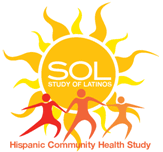| Title | Neighborhood Factors as Predictors of Poor Sleep in the Sueño Ancillary Study of the Hispanic Community Health Study/Study of Latinos. |
| Publication Type | Publication |
| Year | 2017 |
| Authors | Simonelli G, Dudley KA, Weng J, Gallo LC, Perreira K, Shah NA, Alcantara C, Zee PC, Ramos AR, Llabre MM, Sotres-Alvarez D, Wang R, Patel SR |
| Journal | Sleep |
| Volume | 40 |
| Issue | 1 |
| Date Published | 2017 Jan 01 |
| ISSN | 1550-9109 |
| Keywords | actigraphy, Adolescent, Adult, Cross-Sectional Studies, Female, Hispanic or Latino, Humans, Male, Middle Aged, Prevalence, Prospective Studies, Residence Characteristics, Risk Factors, Safety, Sleep Initiation and Maintenance Disorders, United States, Violence, Young Adult |
| Abstract | STUDY OBJECTIVES: To evaluate whether an adverse neighborhood environment has higher prevalence of poor sleep in a US Hispanic/Latino population.METHODS: A cross-sectional analysis was performed in 2156 US Hispanic/Latino participants aged 18-64 years from the Sueño ancillary study of the Hispanic Community Health Study/Study of Latinos (HCHS/SOL). Participants completed surveys of neighborhood environment including perceived safety, violence and noise, the Insomnia Severity Index (ISI), and 7 days of wrist actigraphy.RESULTS: In age and sex-adjusted analyses, short sleep, low sleep efficiency, and late sleep midpoint were all more prevalent among those living in an unsafe neighborhood. After adjustment for background, site, nativity, income, employment, depressive symptoms, and sleep apnea, the absolute risk of sleeping <6 hours was 7.7 (95% CI [0.9, 14.6]) percentage points greater in those living in an unsafe compared to a safe neighborhood. There were no differences in the prevalence of insomnia by level of safety or violence. Insomnia was more prevalent among those living in a noisy neighborhood. In adjusted analysis, the absolute risk of insomnia was 4.4 (95% CI [0.4, 8.4]) percentage points greater in those living in noisy compared to non-noisy neighborhoods.CONCLUSION: Using validated measures of sleep duration and insomnia, we have demonstrated the existence of a higher prevalence of short sleep and insomnia by adverse neighborhood factors. An adverse neighborhood environment is an established risk factor for a variety of poor health outcomes. Our findings suggest negative effects on sleep may represent one pathway by which neighborhood environment influences health. |
| DOI | 10.1093/sleep/zsw025 |
| Alternate Journal | Sleep |
| PubMed ID | 28364454 |
| PubMed Central ID | PMC5804993 |
| Grant List | K24 HL127307 / HL / NHLBI NIH HHS / United States K23 HL125748 / HL / NHLBI NIH HHS / United States KL2 TR000461 / TR / NCATS NIH HHS / United States K23 HL125923 / HL / NHLBI NIH HHS / United States N01HC65236 / HL / NHLBI NIH HHS / United States N01HC65235 / HL / NHLBI NIH HHS / United States N01HC65234 / HL / NHLBI NIH HHS / United States N01 HC065237 / HC / NHLBI NIH HHS / United States N01HC65233 / HL / NHLBI NIH HHS / United States N01HC65237 / HL / NHLBI NIH HHS / United States L60 MD005231 / MD / NIMHD NIH HHS / United States P2C HD050924 / HD / NICHD NIH HHS / United States N01 HC065234 / HC / NHLBI NIH HHS / United States R01 HL098297 / HL / NHLBI NIH HHS / United States |
Neighborhood Factors as Predictors of Poor Sleep in the Sueño Ancillary Study of the Hispanic Community Health Study/Study of Latinos.
MS#:
0283
ECI:
Yes
Manuscript Status:
Published
